Odds & Ends: Core Set 2019 Strikes Again
During these last two weeks, I've been answering your questions about Core Set 2019. You asked so many good questions, I decided to make a third and final column.
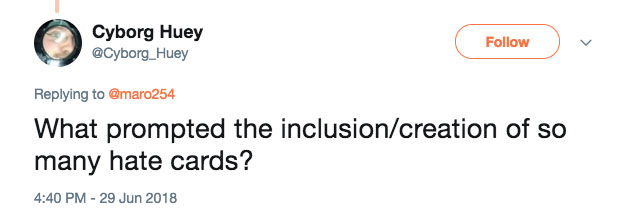
As long-time readers know, I consider the Magic color wheel to be the most important facet of the game. It's at the center of both mechanics and flavor. As such, it's important to introduce the color wheel to beginners. Part of doing that is communicating the relationship between the colors. Hate cards are a good way of stressing that certain colors are enemies with other colors. R&D has gone back and forth over the years about how powerful hate cards are supposed to be (and at what volume they're supposed to exist), but all of us agree they should exist in some amount at the right power level. Enough that someone can learn to sideboard it in against their friend who always beats them, but not so strong as to drive colors out of the metagame.
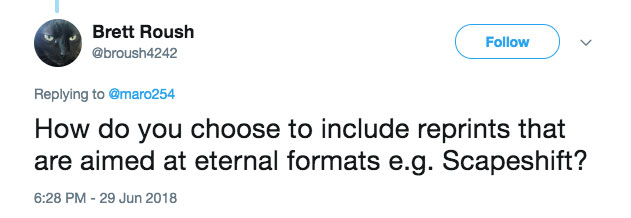
The Play Design team is responsible for keeping their eye not just on Draft and Standard, but on all popular formats. When looking for new cards to go into older formats, they did research on what decks are popular and methodically figured out what pieces were missing that would help out decks that were close but not quite competitive or were answers for decks that the format wanted more answers for. For reprints, they looked a lot at what cards people were expressing a desire for and then figured out which of those cards could exist in Standard without causing too much of a fuss. The team started out being very aggressive in their reprint selection and then, through some playtesting, pulled back to the cards that weren't warping Standard.
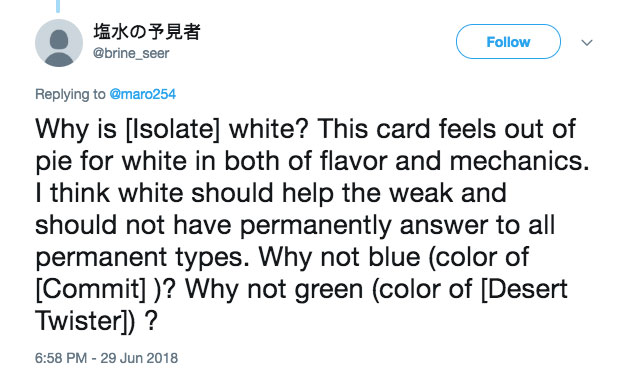
So, let's start with the assumption that you want a monocolored card that has this ability and a converted mana cost of 1 (this card was specifically designed to be relevant in older formats). What can this card destroy? Any permanent that has a converted mana cost of 1—artifacts, creatures, and enchantments. Lands don't have a converted mana cost and no planeswalkers currently exists that cost 1 (yes, there are one-drops that can transform into planeswalkers). White, red, and green can destroy artifacts. White, black, and red can destroy creatures. White and green can destroy enchantments. The only color capable of destroying all three is white, which is why white was chosen.
Commit (from Commit // Memory) is not a good example, as that is a (super) bounce effect and not a destruction effect. One of blue's weaknesses is its inability to destroy permanents (with the sole exception of when its changing one into another permanent). Desert Twister is not a good example as it's a classic case of a green card out of color pie. (You can read my story of trying desperately to keep it out of Fifth Edition here.) Is it a weird effect in white? Yeah, it's a bit of a bend, although not a break (it doesn't undercut the weakness of the color). Normally, I would push off an effect that's not clearly a single color to a multicolor card, but that's impossible to do with a one-drop spell (okay, you could make it hybrid and technically make it multicolor, but that's making the problem more difficult as you need two colors you can do it in).
Yes, it's a bit odd, but white is the best fit for the card.
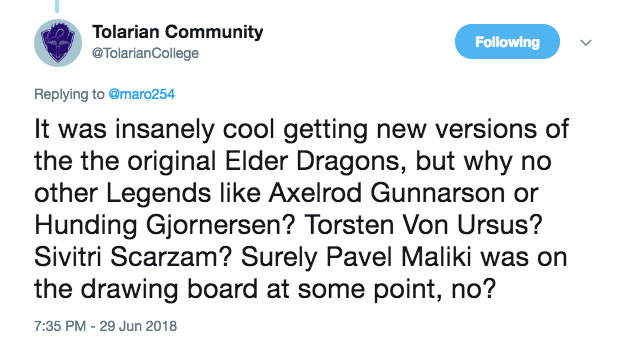
While I love interacting with the fans on social media, I'll admit that, at times, I get sick of all the "make a new Pavel Maliki" messages I get. Is he a truly generous person or just someone atoning due to some unspecified obligation? The public wants to know. And we want to tell them. The problem though was all the characters from the past in Core Set 2019 had a connection to Nicol Bolas. While Pavel Maliki and Bolas were both in Legends, our research couldn't find any connection between the two. Had they maybe been roommates at some point or maybe Bolas once loaned Pavel money? Maybe that was the obligation Pavel was possibly atoning for. The deeper we looked though, the less we came up with. I suggested we make a new multicolored 5/3 that firebreathed for two colors of mana with a name like Mavel Paliki, but it was clear I was just grasping at straws. One day, I vow we'll find a way to bring Pavel Maliki back—sadly, Core Set 2019 wasn't going to be that day.
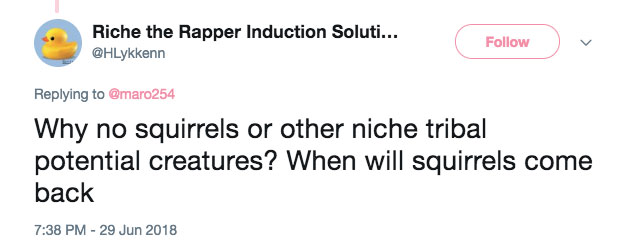
We've been getting much more proactive about doing niche tribal cards in normal expansions, so we didn't feel a strong need to do a lot of it in Core Set 2019. As for Squirrels, I feel it's time for my next internal push for their return in black-border Magic. They were a big hit in Unstable, so I'll see what I can do. I should note that my attempts over the last fifteen years to bring them back haven't been all that successful.
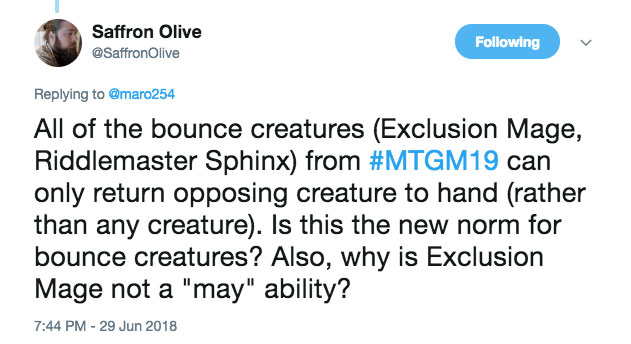
One of the responsibilities of making a game in both a tabletop and a digital version is being aware of the needs of each. The limitation on bouncing (aka returning creatures to their owner's hand) is in response to the needs of digital Magic. It's very frustrating to intend to bounce one of your opponent's creatures only to click on your own accidentally, so we are always asking when we do effects how often we feel they'll serve a different purpose. If that answer is high enough, we'll include the more open-ended targeting, but if, as with Core Set 2019, we feel the cards will primarily be used a certain way, we'll template them with the friendlier for digital version. What this means is that whether a card bounces any creature or just an opponent's will vary depending on the set it's in.
The "may" templating is another digital issue. Anytime we say "may," we're adding another click to digital play. If it's something we feel is mechanically relevant, we'll add the may and suck up the extra click, but if the card is primarily something you're going to want to do almost all the time, we've chosen to remove the "may."
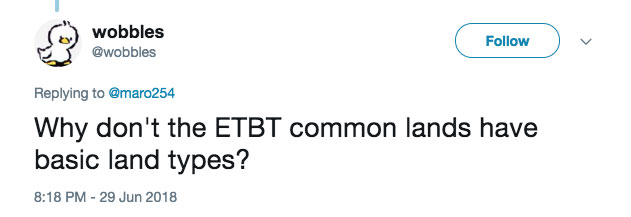
The simple answer is that all ten are reprinted cards and the original versions didn't have basic land types, but I'm assuming the real question is why didn't those cards have basic land types in the first place. The answer is that part of making a trading card game requires learning to be a little stingy. We make hundreds of new cards every year, so it's important that we recognize valuable resources and dole them out carefully. I'll use basic land subtypes as an example.
Being a basic land is mostly a positive attribute for a land to have (yes, there are the occasional hosers, but they're greatly outnumbered by the cards that positively interact with the land types). As such, it's something players want on their lands. We could just put it on any land whose power level allowed it, and for a time, that would be exciting. The problem though is when you do anything enough, it stops being something players look forward to and starts to be something they expect. Instead of being excited when they see it, players get upset when they don't. We take a resource that brought joy to players and turn it into something that more often upsets them.
In addition, we've lost a resource we can use to get players excited. We have to make a lot of cards. That's a resource we must be careful with. It's why not every basic land is full art. It's why we don't maximize every card with as many creature types as can fit on it. It's why I've been slow-rolling planeswalker advancements. Our job is to excite all of you, and sometimes that means taking things we know you like and doling them out slowly.
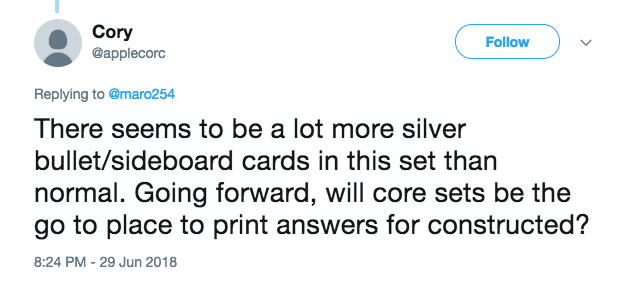
This is a recurring theme in my Core Set 2019 mailbag articles. We're experimenting with the core set. We brought it back because we felt there were numerous ways we could use them that the previous model wasn't allowing us to do. Silver bullet/sideboard cards is one facet of that issue. They seem to work particularly well in core sets because they tend not to warp Standard while being relevant in other formats due to their niche nature. We're going to look at all the data on Core Set 2019 and then apply that to core sets in the future. The preliminary data so far, however, looks good.
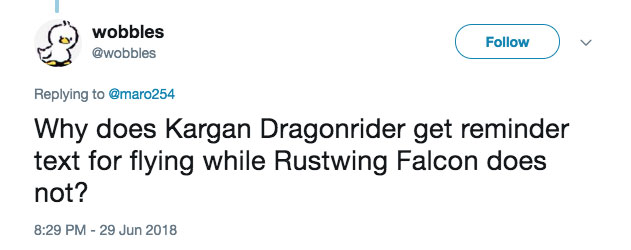
I'm going to teach you a little trick. Look at the collector number. Whenever it's higher than the number of cards in the set, that's an indicator that it's a Planeswalker Deck unique card. The reason I point this out is that you can see that Kargan Dragonrider is a Planeswalker Deck unique card while Rustwing Falcon is not, meaning that while it shows up in Ajani's deck, it's also in the main Core 2019 set.
We made a decision to keyword flying in the Planeswalker Decks but not in the main set. As Rustwing Falcon appears in both and we didn't want to have two distinct versions of it (we don't like making collectors have to hunt down very similar but slightly different versions of cards from the same set), Rustwing Falcon does not keyword flying. It's a little odd, I agree, but we decided we'd rather the new player sometimes see the reminder text than never see it.
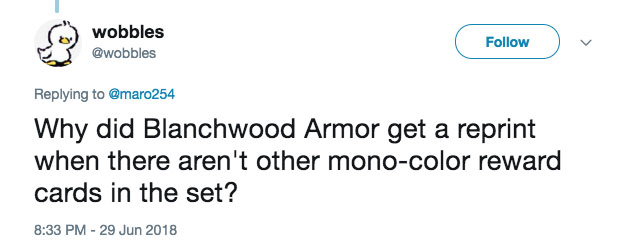
Just because a card is originally designed as part of a cycle doesn't mean it has to be reprinted as a cycle. As to why green has more green/Forest-caring cards than other colors, that's not something we always worry about balancing. It's okay for different colors to be stronger in certain areas than others. Blanchwood Armor got reprinted in particular because we know from experience that it's a very popular card with beginners, and a big part of the core set is to have a lot of cards that can create early "wow" moments in playing.

No, mostly because "Salad" was, as a set, never designed. "Soup" (aka Dominaria) mapped out some design space for it, made a mechanic for it, and pushed off some cards for it, but the decision to return to the core set was made before set design for "Salad" ever began. (Vision design was done for the whole block at the time and not a single set.) There were a few things we saved for "Salad" that later got added to Dominaria in set design, the largest being the "one legendary creature per pack" idea.

We've made the conscious choice in the new core sets to not bring back an old mechanic each time. Slivers, while not technically a keyword, acts a lot like a mechanic. In fact, Magic 2014 chose to bring back Slivers as its returning mechanic. I expect us to revisit Slivers again, but I don't expect it to be in a core set.
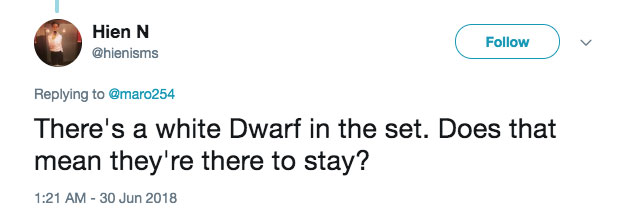
The card's design felt very Kaladeshian, and on Kaladesh, in white, the card would be a Dwarf, so it was concepted as a Dwarf. I wouldn't read into it any more than that. I'm honestly not sure of the future of Dwarves in white. The response to them was kind of middle of the road, so I'm not sure what the future holds.
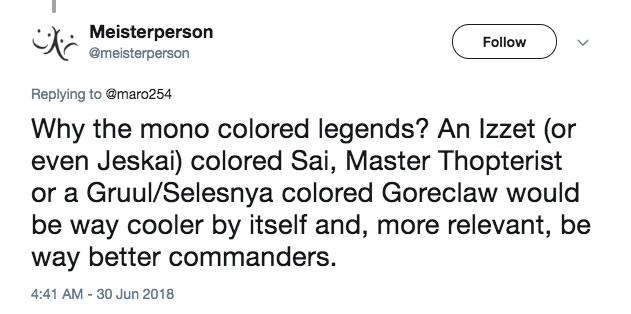
Two things:
- There's a much broader audience for legendary creatures than Commander (and Brawl) players. While many legendary creatures are designed specifically with Commander in mind, not all of them are.
- Even within Commander (and Brawl), there are a lot of players who enjoy playing monocolored commanders. As I like to say, restrictions breed creativity, and it's fun to have a commander that forces you to get a bit more creative to make it work.
Until We Tweet Again
Once again, that's all the time I have for today. As always, if you have any comments on today's article, on any of my answers, or on Core Set 2019 itself, please feel free to email me or contact me through social media (Twitter, Tumblr, Google+, and Instagram).
Join me next week for this year's State of Design article.
Until then, may you keep asking questions like "When is the next Core Set 2019 draft?"
#561: GDS3 Final Day
#561: GDS3 Final Day
After three trials and five design challenges, the GDS3 top three came to Wizards' offices for the final day of the competition. This podcasts talks all about the final day of GDS3.
#562: Vision, Set, Play Design Retrospective
#562: Vision, Set, Play Design Retrospective
41:39
It's been two years since R&D started the new Vision Design, Set Design, Play Design model. In this podcast, I take a look at it and judge how I think it's going.
- Episode 560 Tuesday Magic Meeting
- Episode 559 Unstable Cards, Part 6
- Episode 558 Unstable Cards, Part 5

